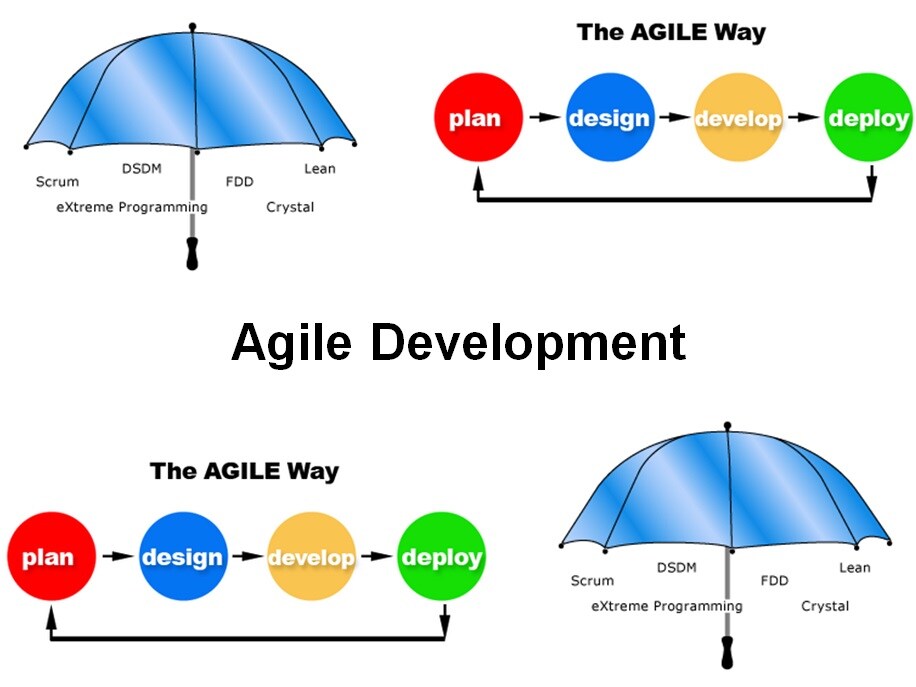-
Learning by doing
-
Trainers with practical experience
-
Classroom training
-
Detailed course material
-
Clear content description
-
Tailormade content possible
-
Training that proceeds
-
Small groups
In the course Agile Development participants learn the concepts, methods and practical techniques of Agile software development. In an Agile Development method, progress is measured on the basis of working products, features and prototypes. Not piles of paper but working software.
The course Agile Development begins with a discussion of the origins of the term Agile with the creation of the Agile Manifesto by a number of software developers in 2001 in Utah.
Attention is paid to roles and role identification in Agile, working in teams and reaching consensus. In Agile Development the emphasis is on direct communication, preferably as personal contact, instead of written reporting.
Next it is discussed how the Agile development process is divided into short iterations to avoid risks. At the end of each iteration both the delivered product and the development process are assessed.
The importance of user stories, estimates and planning in Agile are also covered in the course Agile development. The full cycle of a typical Agile development project is executed from writing a user story to its implementation and delivery.
Finally it is treated how iterations in Agile development are planned and executed, what the place is of Daily Standups and how metrics can be applied to Agile development projects.
During the course Agile Development participants work in teams and put Agile into practice through hands-on exercises that strengthen the understanding of the ins and outs of Agile development. At the end of the course Agile Development participants will have the practical knowledge needed to get started with Agile development.
Th3 course Agile Development is intended for developers, testers, project leaders and managers who want to gain knowledge about the design of an Agile software development process.
To join the course Agile Development no specific skills are required. General knowledge of system development is beneficial for a proper understanding.
The theory is discussed on the basis of presentation slides. The steps in an Agile development process are practiced using short case studies. The course times are from 9.30 up and to 16.30.
Participants receive an official certificate Agile Development after successful completion of the course.

Module 1 : Agile Intro |
Module 2 : Agile Roles |
Module 3 : Agile Teams |
|
Development Methodologies Agile Introduction Agile versus Waterfall History of Agile The Agile Manifesto Agile Methods Method Differences Including Feedback Iterative Development |
Role Overview Leadership in Agile Product Owner Team Lead Development Members User Roles for Stories User Roles for Requirements Domain Experts Stakeholders |
Self Organizing Teams Empowered Teams Team Dynamics Achieving Consensus Meeting Rules Team Charters Vision and Strategy Road Mapping Building the Product Backlog |
Module 4 : User Stories |
Module 5 : Estimation |
Module 6 : Planning |
| User Story Parts Acceptation Criteria Why User Stories? Gathering Stories Requirements Gathering Writing User Stories Acceptation Criteria Prioritization Story Mapping |
Intro Estimation Conventional Estimation Problems Function Point Analysis Agile Estimations Feature Estimation Story Points Estimations Free Planning Affinity Mapping Data Estimation with Velocity |
Release Planning Process Schedule Based Release Planning Scope Based Release Planning Keeping the Release Plan Iterative Planning Defining Done Capacity Planning Detailed Planning Planning for Chaos |
Module 7 : Iterations |
Module 8 : Metrics |
|
|
Planning Iterations Iteration Execution Timeboxing Reviews Three Themes of Iteration Execution Conducting Daily Standups Foul Team Smells |
Sprint Demo's Metrics and Reporting Cost of Metrics Traditional Metrics Problems Understanding Agile Metrics Retrospectives Effective Retrospectives |
